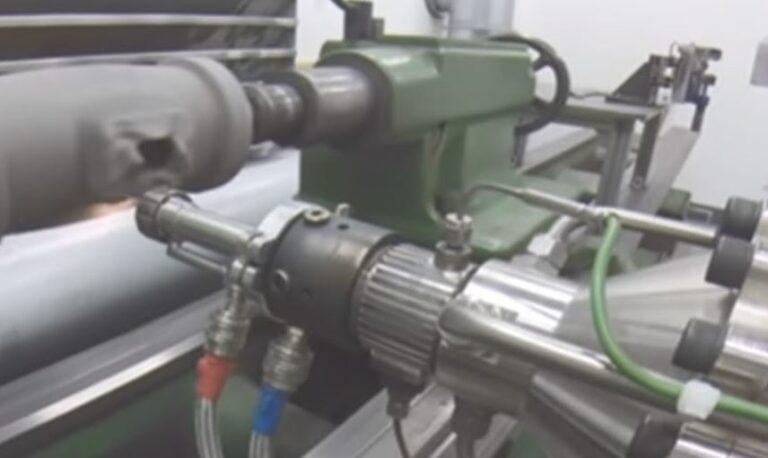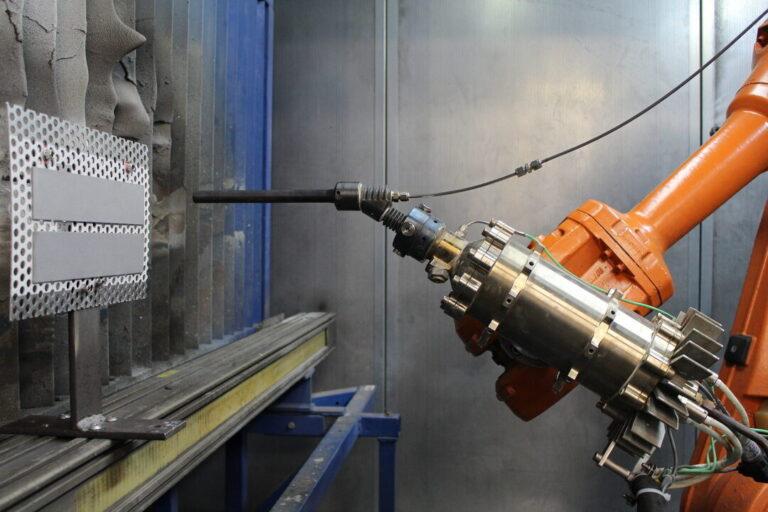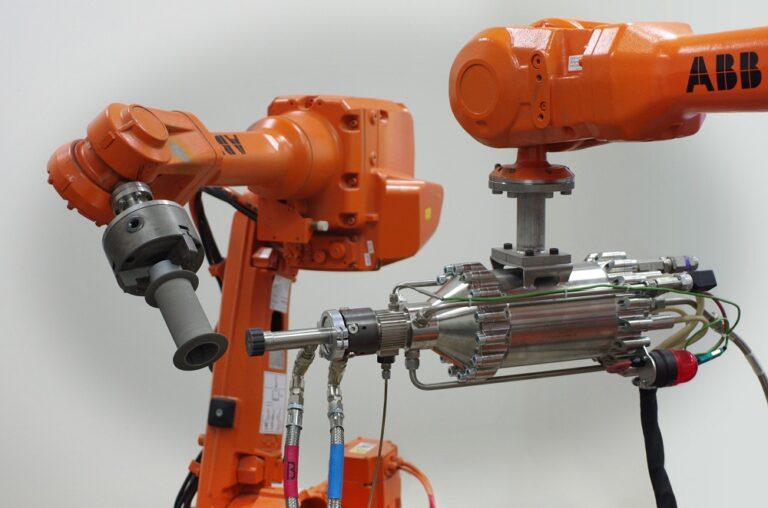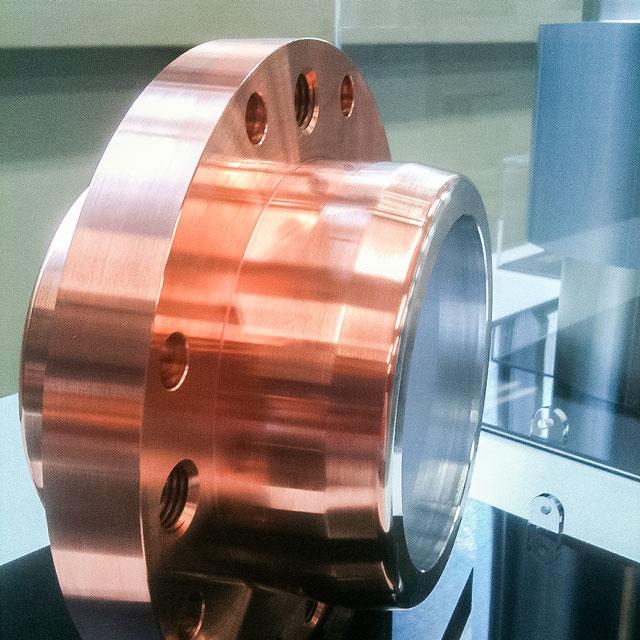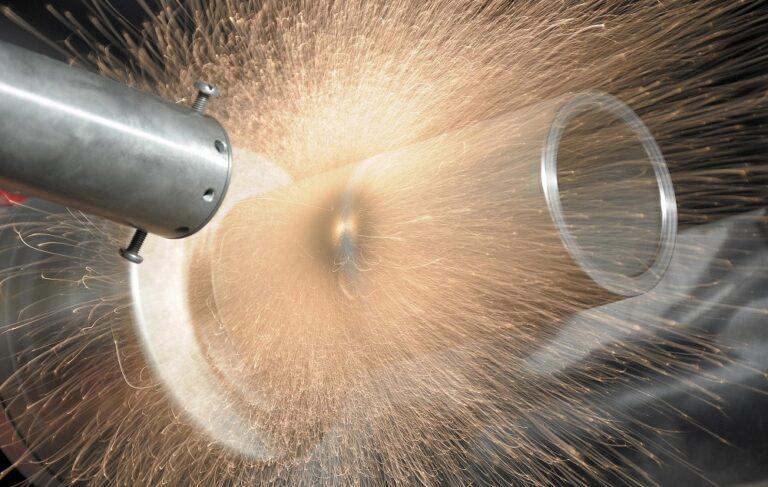Cold Spray Additive Manufacturing: Advancements and Challenges
Introduction
Cold Spray Additive Manufacturing (CSAM) is a modern production technique. It creates complex metal structures without traditional methods. CSAM uses high-speed metal particle acceleration and deposition. Unlike 3D printing and laser sintering, it does not rely on melting. This method uses high-pressure gas to accelerate metal particles to speeds greater than 1000 m/s. Particles distort and connect with one another when they strike the surface to create a solid, dense layer.
CSAM is important due to its exceptional mechanical qualities in metal coatings and structures. These qualities include high strength, ductility, and wear resistance. CSAM has demonstrated high effectiveness in various industries, such as aerospace, automotive, and biomedical engineering. Accuracy and quality are crucial in these industries.
Despite its many benefits, there are some difficulties with the CSAM method. The pricey and highly specialized equipment needed for CSAM makes it challenging for smaller businesses to use the technology. The restricted supply of acceptable feedstock materials constrains the spectrum of metals that can be employed in the process. Additionally, the CSAM process takes enormous amounts of energy, which might contribute to a high environmental impact.
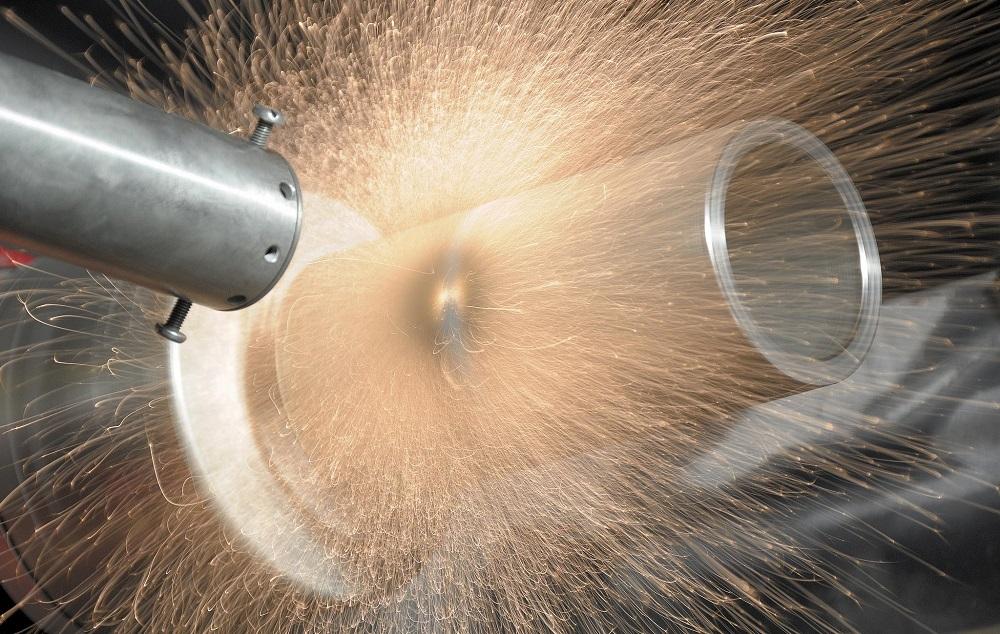
CSAM technology has seen significant advancements in recent years. These advancements include better process control, increased material compatibility, and improved post-processing. However, there are still challenges to overcome in CSAM technology. To create a more effective and sustainable manufacturing process, this study will examine CSAM developments and difficulties. The study will offer viable methods to address these issues.
Definition of Cold Spray Additive Manufacturing (CSAM)
Cold spray additive manufacturing (CSAM) is a revolutionary technique. It deposits metal particles onto a substrate to create a solid structure or coating. The process accelerates small metal particles to supersonic speeds and directs them to coat the surface. It heats the particles to a temperature just below their melting point and then propels them using a high-pressure gas. Commonly nitrogen or helium is used as the gas. In CSAM, the material is added to a surface layer by layer. This is different from conventional manufacturing methods like casting or machining.
Traditional manufacturing processes cannot produce complex geometries and structures, but this procedure enables their production.
Producing dense, higher-quality coatings and structures with exceptional mechanical qualities is one of CSAM’s distinctive advantages. The metal particles hit the surface with high impact velocity, deforming them. This process attaches the particles to the surface. CSAM produces high-quality coatings and structures with superior mechanical qualities. The resulting products exhibit high strength, ductility, and wear resistance.
Several industries, including aerospace, automotive, and biomedical engineering, use CSAM in a variety of ways. The technology creates high-quality structures and coatings. These structures and coatings satisfy demanding criteria. The technology has been proven. The sectors benefiting from it demand high quality. The procedure best suits high-performance coating or construction applications where accuracy, quality, and efficiency are essential components.
CSAM is a revolutionary manufacturing method. It uses supersonic metal particle acceleration. It creates high-quality coatings and structures with better mechanical qualities. The technology has a wide range of uses for many different industries. Experts expect it to completely transform the manufacturing sector in the next few years. In conclusion, CSAM is a game-changing technology.
CSAM components
Cold Spray Additive Manufacturing (CSAM) is a complex process. It involves several components working together. The goal is to produce high-quality metal coatings and structures. The components can be classified into three categories. These are the powder feeder system, gas acceleration system, and nozzle assembly.
powder feeder system
The powder feeder system is responsible for delivering the metal particles to the gas acceleration system. The system has a hopper for storing metal powder. A feeder meters the powder into the gas stream. This is a typical setup for Cold Spray Additive Manufacturing (CSAM). To ensure a uniform coating or structure, the powder feeder must deliver a consistent flow of powder.
gas acceleration system
The gas acceleration system is responsible for accelerating the metal particles to supersonic speeds. It typically consists of a high-pressure gas supply, a mixing chamber, and a converging-diverging nozzle. The operator mixes the metal powder with high-pressure gas. Then, they heat the mixture to a high temperature. Afterward, they accelerate it through the nozzle. They use a specially designed converging-diverging nozzle. The nozzle increases gas velocity and decreases gas pressure. This acceleration propels metal particles to supersonic speeds.
nozzle
The accelerated metal particles are directed onto the surface to be coated by the nozzle assembly. It typically consists of a nozzle body, a supersonic gas jet, and a powder injection port. Designers need to design nozzle assembly carefully. They must ensure a uniform distribution of metal particles onto the surface. They also need to prevent excessive heating or deformation of the substrate.
The powder feeder system, gas acceleration system, and nozzle assembly collaborate to create a high-velocity jet. The jet is made of metal particles that impact the surface to be coated. The impact results in the formation of a dense, high-quality coating or structure. Overall, these components work together in Cold Spray Additive Manufacturing (CSAM).
Importance of CSAM in modern manufacturing
Cold Spray Additive Manufacturing (CSAM), a cutting-edge manufacturing technique, has transformed the way we make metal coatings and structures. Technology is a crucial component of contemporary manufacturing since it has a number of advantages over conventional manufacturing methods.
CSAM has the ability to produce high-quality coatings and structures. The process involves depositing metal particles onto a surface at supersonic speeds. This creates a dense coating or structure with exceptional mechanical properties. The resulting products have high strength, ductility, and wear resistance. Because of this, CSAM excels in high-performance fields including aerospace, automotive, and biomedical engineering.
CSAM can create intricate geometries and structures not possible with conventional methods. It uses an additive manufacturing approach. Material is added layer-by-layer to a surface for precise and accurate production. CSAM has a number of environmental advantages over conventional manufacturing methods. The process produces less waste than other methods. It can recycle and reuse metal particles. The particles don’t attach to the surface. The procedure is also chemical- and solvent-free, making it a green alternative for the creation of metal coatings and structures.
CSAM is a crucial tool for modern production. It can build complicated geometries and structures. It produces dense, high-quality coatings and structures with superior mechanical qualities. CSAM offers environmental advantages over conventional manufacturing methods. In conclusion, CSAM is an important aspect of modern manufacturing. The future of manufacturing relies heavily on technology, which has numerous applications across several industries.
A brief overview of the advancements and challenges in CSAM
Cold Spray Additive Manufacturing (CSAM) has advanced significantly in recent years.
These advancements led to improved capabilities and increased applications in various industries.
The development of a multi-material cold spray is one of the most significant advancements.
It enables the deposition of multiple materials in a single process. This has opened up new possibilities for creating structures and coatings with customized material properties for specific applications.
Another significant advancement is the use of machine learning and artificial intelligence to optimize the CSAM process parameters. Analyzing data from previous experiments helps these technologies. They can identify optimal process parameters for a given material and application. This results in increased efficiency and improved product quality.
Despite these advancements, CSAM still faces several challenges. The limited range of materials that the cold spray process can deposit is one of the most significant challenges. The technology can deposit metals and some alloys, but not ceramics and polymers. The deposition of thin coatings with high adhesion is challenging. Surface roughness and cleanliness are crucial in the CSAM process.
Another challenge is the limited understanding of the microstructure and properties of the deposited material. CSAM produces high-quality coatings and structures. Limited knowledge of the deposited material can restrict its use in certain industries. The microstructure and properties of the material need further study. This can lead to wider adoption of CSAM-produced materials.
CSAM has advanced significantly, but it still faces challenges. One challenge is expanding the range of deposit able materials. Another challenge is understanding the deposited material’s microstructure and properties. Despite these challenges, CSAM shows promise in producing high-quality coatings and structures. It also offers superior mechanical properties and can create complex geometries. Various industries can benefit from this promising technology.
Advancements in CSAM
Recent developments in Cold Spray Additive Manufacturing (CSAM) have increased capabilities and broadened applicability across a variety of industries. One notable development is the multi-material cold spray. This allows the deposition of various materials in a single process. This innovation has created new opportunities for developing coatings and structures with specialized material qualities for particular uses.
Applying machine learning and artificial intelligence to optimize cold spray process parameters is a key development in CSAM. These technologies examine data from prior experiments. They determine the best process parameters for a particular material and application. This leads to better productivity and higher-quality products.
Improvements in cold spray equipment design have enhanced process control. It is possible to deposit materials onto intricate geometries. Recent developments have increased the adherence and densification of coatings and structures. Regulation of temperature and pressure of gas used has helped in the deposition process.
Moreover, scientists are looking into the use of CSAM to create high-performance alloys, composites, and nanomaterials. These materials have high strength, wear resistance, and biocompatibility. They are suitable for aerospace, automotive, and biomedical engineering applications. Their exceptional qualities make them ideal for a variety of applications.
In conclusion, CSAM has improved and broadened the types of materials that can be deposited and has enhanced process control and effectiveness. These developments, together with the capacity to produce high-performance materials, make CSAM a potential technology for numerous industries.
Improved coating quality and performance
The advancements in Cold Spray Additive Manufacturing (CSAM) have led to improved coating quality and performance. The ability to control the process parameters and deposit materials onto complex geometries has resulted in coatings with improved adhesion and densification. Additionally, the development of multi-material cold spray has enabled the creation of coatings with tailored material properties, such as increased wear resistance or corrosion resistance. These improvements in coating quality and performance make CSAM an attractive technology for various industries, including aerospace, automotive, and biomedical engineering, where high-performance coatings are crucial for protecting components and extending their service life.
Increased material compatibility and versatility
The advancements in Cold Spray Additive Manufacturing (CSAM) have also led to increased material compatibility and versatility. The ability to deposit a wide range of materials, including metals, ceramics, polymers, and composites, makes CSAM a versatile technology for various applications. The use of machine learning and artificial intelligence to optimize the process parameters has also enabled the deposition of materials that were previously challenging to process using CSAM. This increased material compatibility and versatility have opened up new possibilities for creating structures and coatings with unique material properties tailored to specific applications. Furthermore, the ability to deposit multiple materials in a single process using multi-material cold spray has further expanded the versatility of CSAM, making it an attractive technology for various industries, including aerospace, automotive, and biomedical engineering.
Enhanced process control and automation
The advancements in Cold Spray Additive Manufacturing (CSAM) have also led to enhanced process control and automation. The use of machine learning algorithms to optimize process parameters has enabled increased efficiency and improved product quality by reducing the need for manual adjustments and interventions during the process. Furthermore, advancements in equipment design, such as improved nozzle control and automation systems, have enabled precise control of the spray pattern and the deposition of the particles. These advancements have led to increased consistency in the deposition process, resulting in improved product quality and reduced production time. Enhanced process control and automation make CSAM an attractive technology for industries where high throughput and consistent product quality are crucial, such as aerospace and automotive engineering.
Advancements in post-processing techniques
Advancements in Cold Spray Additive Manufacturing (CSAM) have also led to improvements in post-processing techniques, which are crucial for enhancing the properties and performance of the final product. One significant advancement is the use of thermal treatment or sintering to improve the mechanical properties and reduce residual stresses in the deposited structures. Another post-processing technique that has gained attention is surface finishing, which involves machining or polishing the deposited structure to achieve the desired surface roughness and finish. These post-processing techniques have enabled the production of high-quality parts and coatings with improved mechanical properties and surface finish, making CSAM a promising technology for various applications, including aerospace, automotive, and biomedical engineering.
Examples of successful CSAM applications in various industries
Cold Spray Additive Manufacturing (CSAM) has shown great potential for various industrial applications, and there are several successful examples of its use in different industries. In aerospace, engineers have used CSAM to repair and restore worn or damaged parts, such as aircraft engine components. For instance, in 2016, General Electric Aviation used CSAM to repair a critical titanium fan blade component in a CFM56-7B engine used in Boeing 737 aircraft. The Federal Aviation Administration (FAA) approved this repair, and it saved millions of dollars in replacement costs.
The automotive industry has used CSAM to repair or modify damaged or worn parts, such as engine blocks or cylinder heads. In 2019, a team of researchers from the University of Manitoba used CSAM to repair a damaged engine block from a Toyota Corolla. The repaired engine block showed improved mechanical properties and was able to withstand high loads and stresses.
The biomedical industry has used CSAM to fabricate implantable medical devices and to repair or modify orthopedic implants. In 2020, researchers from the University of Sheffield used CSAM to fabricate a bioresorbable scaffold for bone regeneration. The researchers made the scaffold of a magnesium alloy and designed it to degrade over time as the bone tissue regenerated, eliminating the need for a second surgery to remove the implant.
These successful examples highlight the potential of CSAM in various industries and demonstrate its ability to produce high-quality and functional parts and coatings. As the technology continues to advance, experts expect that the manufacturing industry will increasingly adopt CSAM and find more applications for it.
Challenges in CSAM
Although Cold Spray Additive Manufacturing (CSAM) offers many advantages, it requires addressing several challenges. One of the main challenges is the limited understanding of the process-structure-property relationships in cold-sprayed materials. This makes it difficult to predict the mechanical and physical properties of the final product and to optimize the process parameters for different applications.
The high cost of the equipment and materials required for CSAM is another challenge. The process requires specialized equipment and high-pressure gas, which can be expensive to maintain and operate. The cost of raw materials, such as powders and gases, can also be a limiting factor for some applications.
The production rate of CSAM is also lower than other manufacturing processes, such as injection molding or machining. This limits its application to small-scale production or repair and maintenance activities. The lack of automated post-processing techniques also adds to the production time and cost, which can further limit its application in high-volume production.
CSAM faces a challenge in the limited range of materials it can use. The process currently limits its application to ductile materials, such as metals and alloys, which restricts its potential in other industries like electronics or plastics. Finally, we still need to overcome some technical challenges, such as developing new gas mixtures or optimizing the powder feedstock to improve process efficiency and quality.
Addressing these challenges requires interdisciplinary research and development efforts, involving materials scientists, mechanical engineers, and other experts. As the technology continues to advance, it is expected that these challenges will be overcome, making CSAM a more competitive and widely adopted manufacturing technology.
Limited availability of suitable feedstock materials
One of the challenges in Cold Spray Additive Manufacturing (CSAM) is the limited availability of suitable feedstock materials. The process requires powders that can be accelerated to high velocities and undergo plastic deformation upon impact with the substrate. The powders need to have a high degree of ductility and good adhesion to the substrate to form a cohesive and dense coating or deposit. However, not all materials meet these requirements, and the range of suitable feedstock materials is limited. This limits the range of applications for CSAM and makes it difficult to achieve the desired mechanical and physical properties of the final product. Addressing this challenge requires the development of new feedstock materials, such as intermetallics, ceramics, or polymers, that meet the requirements of the process and have desirable properties for various applications.
Complex and expensive equipment requirements
Another challenge in Cold Spray Additive Manufacturing (CSAM) is the complex and expensive equipment requirements. The process requires specialized equipment, such as high-pressure gas delivery systems and powder feeders, that can be expensive to purchase, operate, and maintain. Additionally, the process requires precise control of several parameters, such as gas pressure, temperature, and flow rate, to achieve the desired coating quality and deposition efficiency. This requires the use of advanced control systems and sensors, which add to the equipment’s complexity and cost. Addressing this challenge requires the development of more cost-effective and user-friendly equipment, as well as the optimization of process parameters to reduce the reliance on advanced control systems. This could make CSAM more accessible to a wider range of industries and applications, ultimately leading to more widespread adoption of the technology.
Process variability and inconsistency
Process variability and inconsistency is another challenge in Cold Spray Additive Manufacturing (CSAM). The process involves complex interactions between various parameters, such as gas flow rate, powder feed rate, and substrate properties, which can lead to process variability and inconsistency. This can result in variations in the coating quality, deposition efficiency, and mechanical properties of the final product, which can limit its application to critical applications that require high precision and consistency. Addressing this challenge requires the development of advanced process control and monitoring techniques, such as real-time monitoring of process parameters, closed-loop feedback control, and machine learning-based approaches, to ensure consistent and reliable production of high-quality parts. This would increase the confidence of end-users in the technology and enable the wider adoption of CSAM in various industries.
High energy consumption and environmental impact
High energy consumption and environmental impact are additional challenges associated with Cold Spray Additive Manufacturing (CSAM). The process requires the use of high-pressure gas and high-velocity powder particles, which consume a considerable amount of energy. Additionally, the process generates a large amount of heat, noise, and exhaust gases, which can have a significant environmental impact. Addressing this challenge requires the development of more energy-efficient processes, such as the use of alternative energy sources or the optimization of process parameters to reduce energy consumption. Additionally, the development of more environmentally friendly and sustainable powder materials, such as bio-based materials, could help reduce the environmental impact of the process. This would improve the sustainability and acceptability of the technology for various applications and industries.
Limited understanding of the physics behind CSAM
A limited understanding of the physics behind Cold Spray Additive Manufacturing (CSAM) is another challenge in the field. The process involves complex interactions between various physical phenomena, such as gas dynamics, powder particle-substrate interactions, and material deformation and bonding. However, the understanding of these phenomena is still limited, and there are several knowledge gaps and uncertainties that need to be addressed to fully exploit the potential of the technology. Addressing this challenge requires the development of advanced modeling and simulation techniques, as well as the conduct of fundamental research studies to investigate the underlying physics of the process. This would improve the predictability and controllability of the process and enable the optimization of process parameters for specific applications and materials.
Future directions and solutions
There are a number of strategies and solutions that could assist in overcoming the present difficulties and advancing the technology, and the future of Cold Spray Additive Manufacturing (CSAM) looks promising. The creation of new feedstock materials, such as hybrid or composite powders, that could increase the process’s adaptability and material compatibility, is one potential remedy. Additionally, the incorporation of cutting-edge monitoring and control systems, such as machine learning and artificial intelligence algorithms, may improve the consistency and process control of the technology.
Additionally, the technology’s cost-effectiveness and sustainability could be increased by the optimization of process parameters and the creation of more environmentally friendly and energy-efficient processes. Finally, the development of sophisticated modeling and simulation techniques as well as more in-depth research studies could contribute to a better understanding of the physics underlying the process, enabling the development of more effective and dependable CSAM systems for a variety of applications and industries. Overall, these future approaches and solutions might speed up the acceptance and application of CSAM in different industrial industries, resulting in the creation of novel products with enhanced functionality.
Potential solutions to overcome challenges in CSAM
The full potential of cold spray additive manufacturing (CSAM) is constrained by a number of issues. To overcome these difficulties and progress the technology, there are a number of alternative options. an a large number of people in the target range of the source of the the target range of the source of the the a prospective new source of the a This could be accomplished by creating novel materials that are more suited to the CSAM process, such as hybrid or composite powders. Enhancing process control and consistency through the integration of cutting-edge monitoring and control technologies, such as artificial intelligence and machine learning algorithms, is another potential solution. This would help increase the process’ predictability and controllability, which would result in better part quality and less variability.
Another way to address difficulties with CSAM is to simplify and reduce the cost of the equipment. This might be accomplished by creating more accessible, small, and economical machinery for a larger range of enterprises. Moreover, more sophisticated post-processing methods could be created to enhance the surface smoothness and general quality of the parts created by the CSAM process.
Finally, addressing the effects of CSAM on the environment is a significant possible solution. Optimizing the process to reduce energy use, noise, and exhaust gases is one way to achieve this. Moreover, using more environmentally friendly and sustainable feedstock materials, like bio-based materials, could lessen the process’s negative effects on the environment. These prospective solutions could assist in overcoming the difficulties in CSAM and enable the technology to be more generally implemented across diverse production industries, resulting in the development of new and inventive products with enhanced performance and usefulness.
Improved feedstock materials and supply chains
One potential solution to the challenges facing Cold Spray Additive Manufacturing (CSAM) is the development of improved feedstock materials and supply chains. Currently, the limited availability of suitable feedstock materials is a major challenge in CSAM. However, by developing new materials and alloys, such as hybrid or composite powders, that are more compatible with the CSAM process, manufacturers could expand their options for producing complex, high-performance parts. Additionally, optimizing the supply chain to ensure reliable and consistent delivery of feedstock materials would further enhance the potential of CSAM. This could involve developing partnerships with raw material suppliers, improving logistics and transportation, and implementing quality control measures to ensure consistent feedstock quality. By improving feedstock materials and supply chains, CSAM could become a more viable and versatile manufacturing process, with the potential to produce parts with greater precision, strength, and functionality.
Increased collaboration and research in CSAM
Increased collaboration and research in Cold Spray Additive Manufacturing (CSAM) is another potential solution to the challenges facing the technology. By fostering greater collaboration between researchers, manufacturers, and other stakeholders, CSAM could benefit from a more diverse range of perspectives and expertise, leading to the development of more innovative and effective solutions. Additionally, increased funding and support for research and development could help overcome some of the technical challenges facing CSAM, such as process variability and inconsistency, and limited understanding of the physics behind the process. Through greater collaboration and research, CSAM has the potential to become a more widely adopted and transformative manufacturing process, with applications across a broad range of industries and sectors.
Development of scalable and cost-effective equipment
Another potential approach to overcoming the difficulties in Cold Spray Additive Manufacturing is the development of scalable and affordable machinery (CSAM). CSAM is now not accessible to smaller enterprises and startups because to the complicated and pricey equipment needed. CSAM might, however, become a more attractive choice for a larger range of producers by creating more effective and reasonably priced equipment. This can entail utilizing new materials and manufacturing techniques to lower the cost of the equipment as well as the creation of more intuitive and automated technologies to streamline the CSAM procedure. Manufacturers might more readily embrace the technology, increasing innovation and production across a variety of industries, by making CSAM equipment more scalable and cost-effective.
Advancements in process monitoring and control
Another potential answer to the problems in Cold Spray Additive Manufacturing is advancements in process monitoring and control (CSAM). The consistency and quality of CSAM components can be improved with the use of real-time monitoring of process factors like particle velocity, temperature, and gas flow. Moreover, improvements in automation and machine learning might assist to improve process control even more by allowing manufacturers to spot and fix problems in real time. Manufacturers may raise productivity and decrease waste in their CSAM operations by using these cutting-edge monitoring and control solutions. Ultimately, unlocking the full potential of CSAM and allowing its implementation across a variety of industries will depend on developments in process monitoring and control.
Increased awareness and adoption of sustainable manufacturing practices
Another potential approach to overcoming the difficulties in Cold Spray Additive Manufacturing is an increased understanding and implementation of sustainable manufacturing methods (CSAM). There are many issues that need to be solved, including the high energy consumption and environmental impact of CSAM. Manufacturers can lower their carbon footprint and lessen their environmental impact by implementing more environmentally friendly manufacturing techniques, such as employing renewable energy sources or maximizing resource use. This could entail the utilization of recycled materials, the adoption of eco-friendly supply chains, or the creation of CSAM procedures that use less energy. Manufacturers who prioritize sustainability in their production processes not only lessen their environmental effects but also save money and gain the trust of their customers. The long-term survival and success of CSAM will ultimately depend on greater awareness of and the adoption of sustainable manufacturing methods.
Conclusion
In conclusion, Cold Spray Additive Manufacturing (CSAM) represents a promising technology with the potential to revolutionize modern manufacturing. Advancements in CSAM have enabled manufacturers to improve coating quality, increase material compatibility and versatility, enhance process control and automation, and implement post-processing techniques, among other things. Despite these advancements, however, there are still significant challenges that need to be addressed. Limited availability of suitable feedstock materials, complex and expensive equipment requirements, process variability and inconsistency, high energy consumption, and environmental impact, and limited understanding of the physics behind CSAM all present significant obstacles.
Nonetheless, by focusing on potential solutions such as improved feedstock materials and supply chains, increased collaboration and research, the development of scalable and cost-effective equipment, advancements in process monitoring and control, and increased awareness and adoption of sustainable manufacturing practices, manufacturers can overcome these challenges and unlock the full potential of CSAM. As a result, CSAM is poised to play a critical role in shaping the future of modern manufacturing.
Recap of the advancements and challenges in CSAM
Cold Spray Additive Manufacturing (CSAM) is an innovative technology that offers several advancements to modern manufacturing. These advancements include improved coating quality and performance, increased material compatibility and versatility, enhanced process control and automation, and advancements in post-processing techniques. However, CSAM also faces several challenges, such as limited availability of suitable feedstock materials, complex and expensive equipment requirements, process variability and inconsistency, high energy consumption and environmental impact, and limited understanding of the physics behind CSAM. Potential solutions to overcome these challenges include improved feedstock materials and supply chains, increased collaboration and research, the development of scalable and cost-effective equipment, advancements in process monitoring and control, and increased adoption of sustainable manufacturing practices. Despite the challenges, the future of CSAM is bright, as it has already demonstrated successful applications in various industries and has the potential to revolutionize modern manufacturing.
Discussion of the potential impact of CSAM on the manufacturing industry
The manufacturing sector could be significantly impacted by Cold Spray Additive Manufacturing (CSAM). The technology has a number of benefits over conventional manufacturing techniques, including higher process automation and control, improved coating quality and performance, and increased material compatibility. CSAM can also shorten lead times, boost effectiveness, and cut production costs.
The ability to make complex and customizable parts with increased accuracy and precision is one potential impact of CSAM. This might make it possible for producers to make goods that were previously impossible or prohibitively expensive to make using conventional techniques. Additionally, the capacity of CSAM to produce coatings with high wear resistance and low friction may result in better product dependability and longevity, which may find major use in sectors like aerospace and automotive.
The sustainability of CSAM is another potential effect. Because it only deposits material where it is needed and may use recycled materials as feedstock, the method reduces material waste. The ability of CSAM to coat and repair worn-out parts may also increase their lifespan, lowering the demand for replacements and consequently lowering waste.
In conclusion, CSAM could have a major effect on the manufacturing sector. It offers various advantages over traditional processes, including higher efficiency, improved quality and durability, and less waste. CSAM has the potential to transform the manufacturing sector and make it possible to produce complex and bespoke parts with better accuracy and precision as research and development in the area continues.
Joining forces for the future of Cold Spray Additive Manufacturing
It is essential to carry on with research and development in the field in order to fully realize the potential of Cold Spray Additive Manufacturing (CSAM) and its effects on the manufacturing industry. This entails enhancing feedstock resources and supply networks, creating equipment that is scalable and economical, extending process monitoring and control, and expanding collaboration and research.
Through encouraging cooperation between business leaders, academics, and governmental organizations, we as a community must make an investment in the future of CSAM. This will not only result in more technological improvements but will also aid in resolving the difficulties the industry is currently facing.
We can realize the full potential of CSAM technology and influence the direction of manufacturing by continuing to develop and improve it. Together, let’s push the envelope of what is conceivable and develop a manufacturing sector that is more inventive, efficient, and sustainable.
How to design parts for CSAM manufacturing
Designing parts for CSAM manufacturing involves several steps to ensure successful production. The first step is to understand the unique capabilities and limitations of the CSAM process. Next, the design should be optimized for the CSAM process, considering factors such as part complexity, wall thickness, and size. It is also important to consider the material properties and select a suitable feedstock material. The design should be analyzed for potential defects and optimized for structural integrity. Additionally, post-processing steps such as heat treatment or surface finishing should be considered in the design. Finally, it is crucial to collaborate with experienced CSAM manufacturers throughout the design process to ensure a successful outcome.
- Identify the key performance requirements of the part, such as mechanical strength or thermal conductivity.
- Choose a suitable feedstock material based on the performance requirements, availability, and cost.
- Determine the part geometry and tolerances, considering the capabilities and limitations of CSAM processes.
- Define the part orientation and build a strategy to optimize material deposition and reduce the risk of defects.
- Develop a CAD model of the part, accounting for any features that may require additional support structures during printing.
- Generate a mesh model of the part, ensuring that the mesh is of sufficient quality for simulation and analysis.
- Simulate the CSAM process using a suitable software package, such as ANSYS or Abaqus, to evaluate the build quality and identify any potential issues.
- Modify the design as necessary based on the simulation results, taking into account any recommendations for improving printability or reducing defects.
- Validate the final design using physical testing, such as tensile or impact tests, to ensure that it meets the required performance specifications.
- Document the design and manufacturing process to enable repeatability and quality control in future productions.
FAQs
A wide range of materials can be used for CSAM, including metals, ceramics, polymers, and composites. However, the feedstock material must be in powder form and have suitable particle size and morphology for the CSAM process
CSAM offers several benefits, including improved coating quality and performance, increased material compatibility and versatility, and enhanced process control and automation. It also has the potential to reduce waste and increase sustainability in manufacturing.
To ensure the quality of parts produced by CSAM, it is important to optimize the design for the CSAM process, select suitable feedstock materials, and collaborate with experienced CSAM manufacturers. Post-processing steps such as heat treatment or surface finishing may also be necessary to improve part quality. Additionally, rigorous testing and quality control measures should be implemented throughout the production process.

